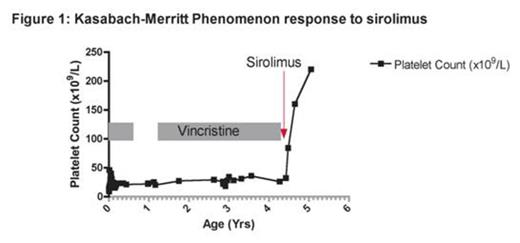Abstract

Kaposiform Haemangioendothelioma (KHE) is a rare vascular tumour of infancy that can be life-threatening from haemorrhage, high output cardiac failure or local tumour effects when associated with Kasabach-Merritt Phenomenon (KMP). The precise pathogenesis of KHE triggered thrombocytopenia and consumptive coagulopathy remains unclear, but treatment with vincristine and steroids is reported as effective and has recently been recommended as first-line therapy in consensus derived practice standards. Therapeutic targets in cases that fail to respond remain empirical and potentially hazardous. Sirolimus is a mammalian target of Rapamycin (mTOR) inhibitor that targets protein synthesis downstream of the Akt pathway. Here we describe the case of an infant girl who presented at birth with an extensive right arm vascular lesion associated with thrombocytopenia, platelet count 12 x 109/L, hypofibrinogenaemia and raised D-dimers, 8336 ug/L. She was anaemic and jaundiced, from a microangiopathic haemolytic anaemia. Tissue biopsy confirmed the histological diagnosis of KHE with characteristic morphology and expression by lesional endothelial cells of D2-40 immunostaining. She commenced steroids and vincristine within the first week of life, but both lesion and thrombocytopenia were resistant. As alternative therapeutic options were limited, she received two protracted courses of vincristine, weekly for 38 weeks, and then every two to six weeks for three years and ten weeks, maintaining a mean platelet count of 25.18 x 109/L, range 9- 46 x 109/L. Severe rectal bleeds with normal histology, epistaxis and a painful enlargement of the KHE toward the wrist mandated an urgent clinical intervention. Additional immunohistochemistry staining demonstrated lesional cells to strongly express anti- ribosomal protein S6 (pS6) and weaker anti- eukaryotic translation initiation factor 4E – binding protein (4E-BPI), both mTOR pathway markers. There was no staining for Vascular derived Endothelial Growth Factor Receptor 3 (VEGFR3). These results plus information from published case reports provided rationale for off-licence use of sirolimus. Within 21 days of commencing sirolimus, with a modest target trough level of<10 ng/ml, the platelet count had risen to 84 x 109/L, and after three months was within the normal range, 164 x 109/L (Figure 1). After six months of the treatment there was remarkable resolution in the size of the lesion and apart from an episode of chicken pox that resolved without complication she had no other side effects or toxicity.
This is the first case report of safe and effective treatment of KMP associated with a KHE with confirmed expression of mTOR pathway markers. This provides a rational use for sirolimus in KHE and KMP and that it should be considered early in life-threatening cases resistant to first line therapy. Further research focusing on the mTOR pathway may provide key insight into the pathogenesis of KMP associated with KHE and elucidate if excess production of VEGF or events downstream of the tyrosine kinase receptor/PI3K/Akt/ mTOR pathway are the initiating mechanism. The lack of VEGFR staining in our patient's histology and lack of anecdotal reports of response with VEGF inhibition suggest a VEGF independent mechanism.
Off Label Use: Sirolimus is a mammalian target of rapamycin inhibitor.
Author notes
Asterisk with author names denotes non-ASH members.

This icon denotes a clinically relevant abstract


This feature is available to Subscribers Only
Sign In or Create an Account Close Modal